Blog

Key Investor Classes Shift to Negative Outlook on Bonds
Four investor classes, foreignrninvestors, the Federal Reserve, fixed income funds, and banks, haverndominated the U.S. Treasury (UST) market in recent years. In arnreport today Bank of America/Merrill Lynch said it sees the future demand from eachrnof the groups now turning negative for the five and ten year part ofrnthe Treasury curve, the area where these investors have been mostrnactive.</p
Foreign investors are the largestrnholders of U.S. Treasuries, with a near 50 percent share ofrnoutstanding debt holdings. In the last five years official foreignrnsources have more than doubled their holdings, from $1.5 trillion inrn2005 to nearly $4.1 trillion today. By far the largest foreignrnholders are China and Japan but other countries holding substantialrnamounts of USTs are Brazil, India, Russia and Switzerland, Theirrncombined holdings has tripled in the last five years. Portfoliorninflows into these countries, fueled by the Fed’s qualitative easing,rnhas led to sizable reserve growth which has been channeled by reservernmanagers back into USTs.</p
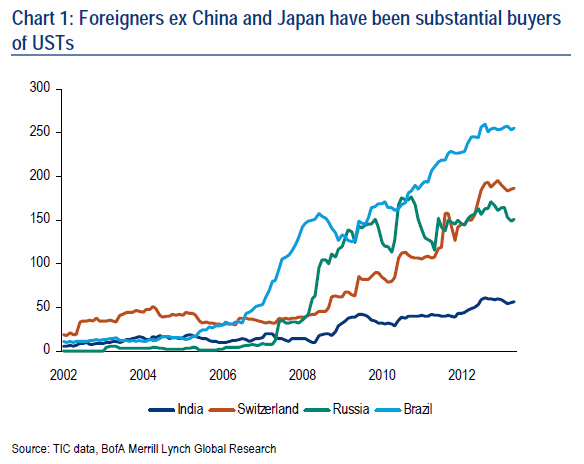 </p
</p
The most public source of demand forrnTreasuries since 2009 has been the Federal Reserve. Since it beganrnthe first round of quantitative easing its portfolio of Treasuriesrnhas grown by nearly $1.5 trillion and the average maturities of thatrnportfolio, in part due to the 15 month life of Operation Twist, hasrnincreased from less than two years before the crisis began to tenrnyears today. </p
The impact of Fed purchases is evidentrnfrom Chart 4 which shows the sky-rocketing share of 5 to 30 year USTrndebt by the Federal Reserve while the level of privately held debtrnhas barely moved. The Fed’s mortgage-backed securities (MBS)rnportfolio has also increased by $1.25 trillion since 2009.</p
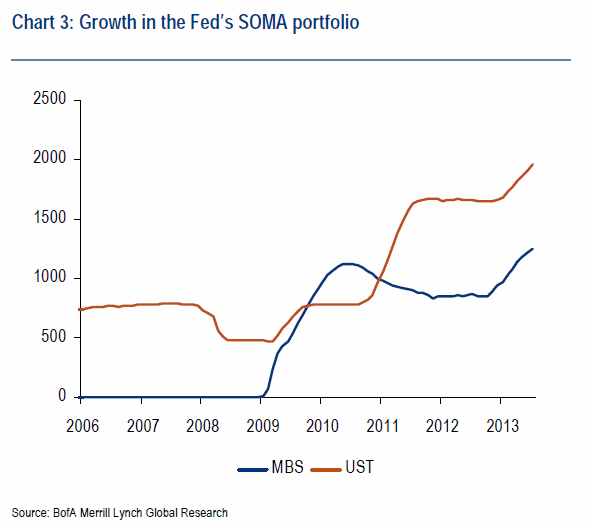 </p
</p
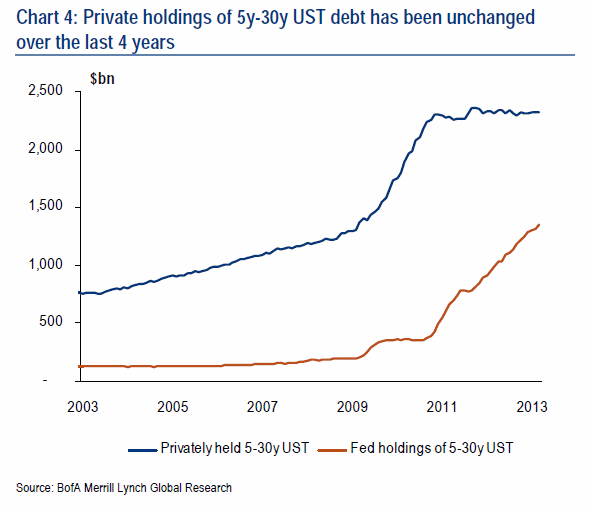 </p
</p
Fixed income funds have increased theirrnTreasury holdings by $400 billion since 2009, while decreasing theirrnshare of equities. Inflows into Treasury-only funds have been small.rn Note that a sizable portion of flows into total return funds isrnlikely to have flown into Treasuries given that they make up arnsubstantial portion of the aggregate benchmark. Overall demand forrnhigh quality duration from these funds have helped keep yields andrnterm premiums at historic lows.</p
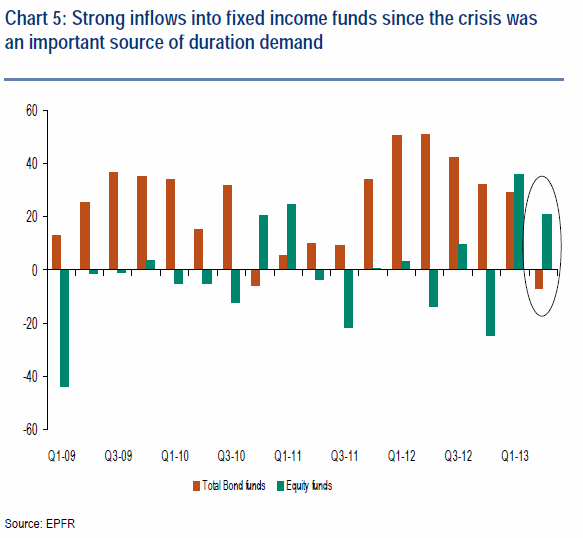 </p
</p
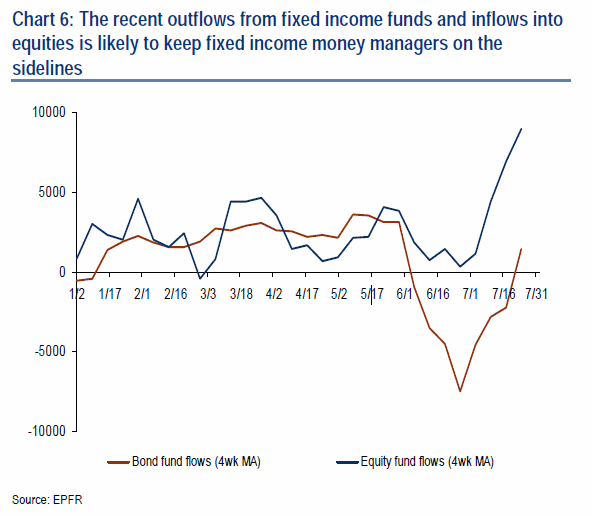 </p
</p
As banks have changed the compositionrnof their balance sheets since 2008, the growth on the asset side hasrnbeen notably tilted toward growth in bank securities as compared withrnloans. Commercial banks hold $2.7 trillion in securities of whichrn$1.8 trillion is in Treasury and agency securities; agency MBSrnholdings total $1.34 trillion and Treasury and agency debt securitiesrntotal $460 trillion. This represents a portfolio growth of $500rnbillion since 2009 all in Treasury and agency securities. </p
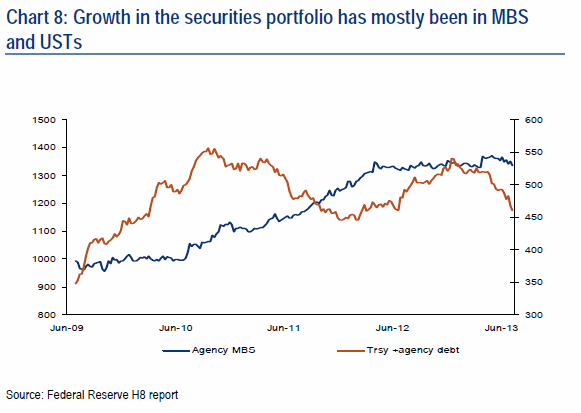 </p
</p
Under pre-Basel III guidelines bankrnregulatory capital ratios are protected from being impacted by markrnto market losses on securities and this has led to banks increasingrntheir holdings of low risk-weighted assets despite duration andrnspread risks. Declining rates and tightening spreads made a furtherrncase for owning these assets. </p
Bank of America says each of these fourrnasset classes faces a changing outlook that may lessen their demand</bfor Treasuries. For emerging market investors, higher interest ratesrnin the U.S. Have triggered large outflows and led to substantialrncurrency depreciation which in turn mean lower reserve growth andrnfewer dollars to be channeled toward Treasuries. In the case ofrncountries such as Turkey, Indonesia, and India, active interventionsrnon behalf of their currencies and the need to sell dollar reservesrnprovide a further negative for demand as Treasuries would be the mostrnliquid assets.</p
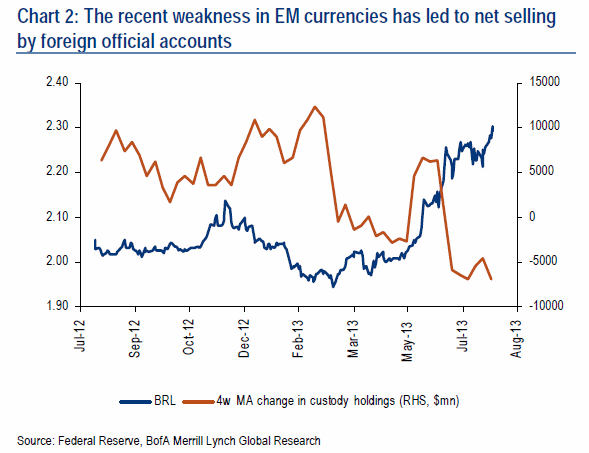 </p
</p
A stronger dollar and weakening safernhave status of both JPY and CHF is likely to mean lesser interventionrnin these countries going forward. Interventions in Japan in 2010 andrn2011 totaled $210 billion, much of which was channeled into USTs. </p
While the timing is still uncertain itrnis obvious that the Federal Reserve is nearing the end of its assetrnpurchase program and will no longer be a large buyer of duration. This means the private market will have to absorb a substantial partrnof the duration supply. Given the durations around which thernquantitative easing programs were centered the point of maximumrnimpact of increased private duration is likely to be in the 5 to 10rnyear part of the curve.</p
Possibly because of the weakness inrnfixed income performance in May, fixed income fund flows reversed inrnJune and July to nearly $25 billion in outflows. The initial flowrnfrom fixed income into cash was not concerning as such moves arerntemporary but recent flows into equity funds are a concern. Equityrnfunds have received nearly $40 billion over the last five weeks andrnfurther inflows into risky assets is likely to mean the start of arnlonger term trend.</p
The three largest U.S. Banks by assetsrnreported a combined $10 billion loss in the second quarter almostrnentirely due to the rise in rates and spreads. Changing Basel IIrnrules mean large banks have to include unrealized gains and losses onrntheir AFS portfolios when calculating regulatory capital. Thusrnanother bad quarter would be even worse under the new rules, not onlyrnhurting shareholder equity but also Tier 1 capital and leveragernrations. In addition, the recovering economy could mean an increasernin loan demand and thus a reluctance for banks to tie up assets inrnlonger-term low-yielding fixed income assets
All Content Copyright © 2003 – 2009 Brown House Media, Inc. All Rights Reserved.nReproduction in any form without permission of MortgageNewsDaily.com is prohibited.
Latest Articles
By John Gittelsohn August 24, 2020, 4:00 AM PDT Some of the largest real estate investors are walking away from Read More...
Late-Stage Delinquencies are SurgingAug 21 2020, 11:59AM Like the report from Black Knight earlier today, the second quarter National Delinquency Survey from the Read More...
Published by the Federal Reserve Bank of San FranciscoIt was recently published by the Federal Reserve Bank of San Francisco, which is about as official as you can Read More...

Comments
Leave a Comment